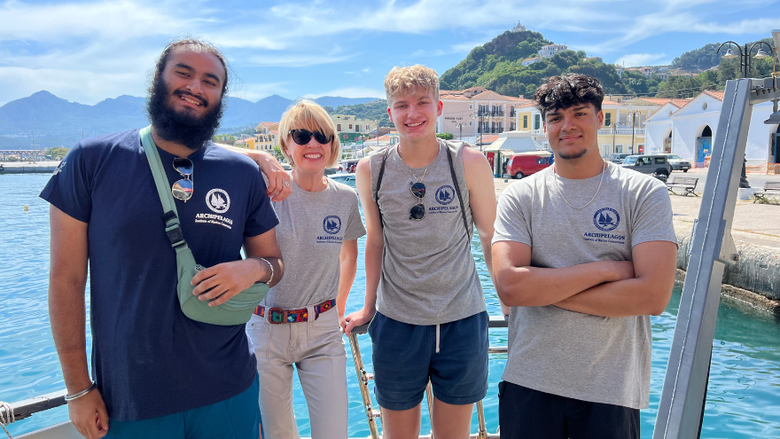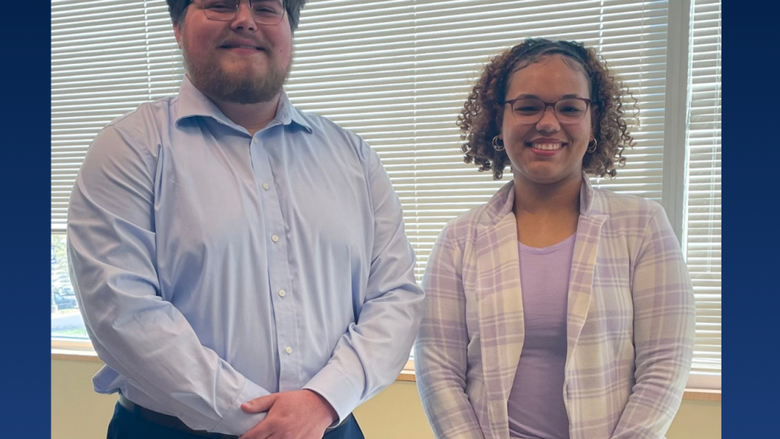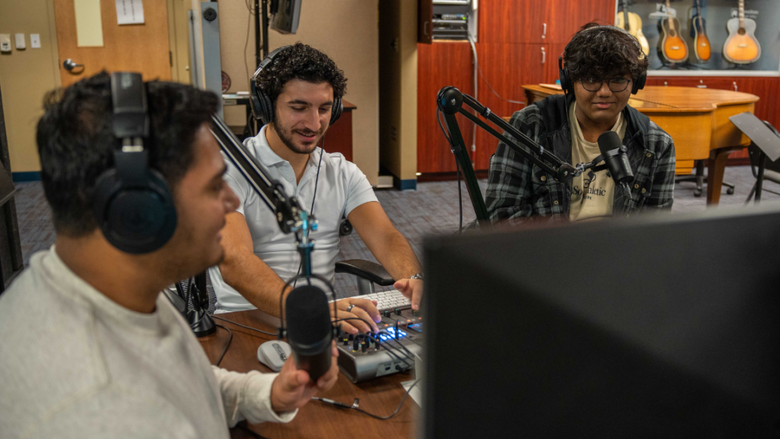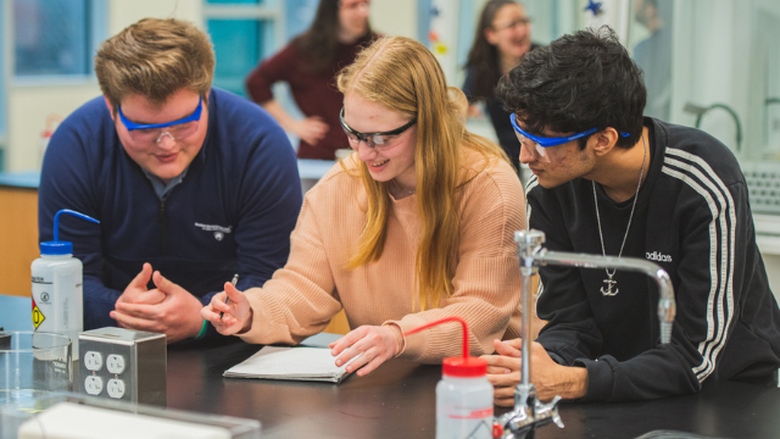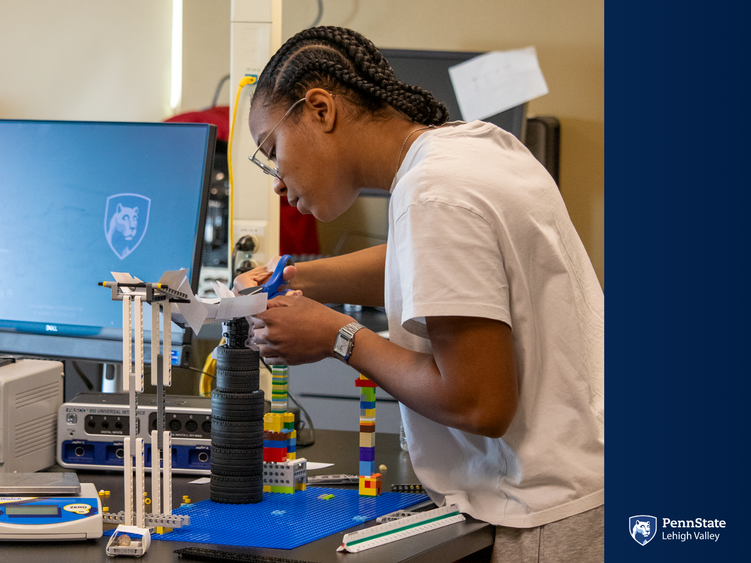
First- and second-year engineering students at Penn State Lehigh Valley participated in an Engineering Design Competition and forensic engineer David Toler gave a presentation, “Making the Case for the Jet Engine”, during National Engineers’ Week, February 16-23.
CENTER VALLEY, Pa. (March 10, 2025)—The Penn State Lehigh Valley (PSU-LV) community learned about different aspects of engineering from two events held during National Engineers’ Week, Feb. 16-23. A guest speaker shared information about the history of the jet engine, and an engineering competition prompted student teams to build a functional project by creating and testing innovative designs. Both events focused on the importance of design within the field, regardless of specialty.
All first- and second-year engineering pre-majors were invited to participate in the First Annual Engineering Design Competition, sponsored by the American Society of Mechanical Engineers (ASME). The students were tasked with building a functional Marble Run using a variety of small tools — Legos, cardstock, Scotch tape and rulers. A few teams were creative and integrated the ruler into their design. The students were evaluated on a series of criteria, which they were given ahead of time.
“Reading it beforehand allowed them to better plan their design,” said Tracey Carbonetto, associate teaching professor of engineering, who organized the competition. “They knew longer runs, vortexes and curves would all be incorporated into a longer time. A few of them had some runs that gave them trouble, so they had to smooth the corners out, raise the slope, or other diagnostic work to make sure the marble made its way down. They came up with some really clever, creative designs.”
The students were given approximately three hours over the course of two days to complete their project — 1.5 hours on the first day to design the run, and 1.5 hours on the second day to build and test it out.
Carbonetto said the students understood working as a team was critically important to complete the project successfully.
“I think the students had a lot of fun. They were intense and demonstrated some really excellent teamwork, even helping out other teams. They all understood teamwork is a big part of engineering, so their ability to do this at this level will contribute to their success," she said.
Student winners were Anwar Abjuinub, Aaron Tyson, Julian Brody and Manny Montalvo, first place, roll time; Christopher Sherman, Christian Myung, Jacob Lewis and Jaelym Penn, first place, roll distance; Peter Fullan, Isaiah Manzo, James Misiti, Aden Broome and Katherine Stawicki, first place, creativity.
Carbonetto is hoping to make this an annual event.
“Competitions are popular. With ASME-provided funding, and Penn State Lehigh Valley close to offering a 4-year engineering degree, I believed the competition would provide a strong foundation for gaining recognition,” she said.
Currently, engineering pre-majors spend two years at PSU-LV and complete their degrees at University Park. PSU-LV is anticipating the acquisition of a 4-year engineering degree soon for students who wish to complete their degrees entirely at the Center Valley campus.
Later in the week, professionally licensed engineer David Toler, former engineer at Pratt and Whitney and owner-principal of forensic engineering consulting firm Forensic Engineering Sciences Inc., spoke about “Making the Case for the Jet Engine.” During his time at Pratt & Whitney, Toler was part of a design team for the F100, a powerful turbofan jet engine used in the U.S. Air Force's F-15 Eagle and most F-16 Fighting Falcon fighter jets. The fan is known for its reliability and high performance in combat situations.
Besides sharing some history of the design of the jet engine, Toler shared a moving graphic to demonstrate the combustion process and machine operation to show the roughly 50 students in attendance how it works.
The historical significance and evolution of design is often overlooked by many engineering students, Carbonetto said. “Storytelling is really important — I think I’ll be including more of the historical aspects of engineering into my classes. It shows the progression of the things we have today, and the thought process behind the design and innovation. For instance, we get on an airplane without thinking about it, where 150 years ago, we didn’t have such a thing. There is a historical progression of design that many students don’t consider.”
Toler’s presentation, though highly technical, genuinely got the students thinking, added Carbonetto.
“Even though some of the information provided might be unfamiliar to the students now, I think they got excited about the fact that someday they’ll also be able to verbalize highly technical concepts,” she said. Toler is a forensics engineer, which means he gathers evidence from design failures such as what happens when a bridge collapses.
National Engineers’ Week and programs that honor the work of engineers allow students to take a deep dive into different aspects of the engineering field and infer more about various career paths. Above all, Carbonetto said, it shows students that the field requires more than a sole love of math and science. Problem solving, critical and creative thinking, and adopting a “team” mentality are other traits required to be a successful engineer.
“One thing both of these programs provide is a glimpse into the future,” Carbonetto said. “Students come to campus and say they want to be an engineer because they’re good at math and science. That’s great — that’s definitely important. But learning about what an engineer does allows students to validate their choice beyond just being good at math and science and say, ‘I’m really interested in the work of an engineer.’”
For more information on PSU-LV’s 2+2 engineering pre-major, visit the program’s website.
